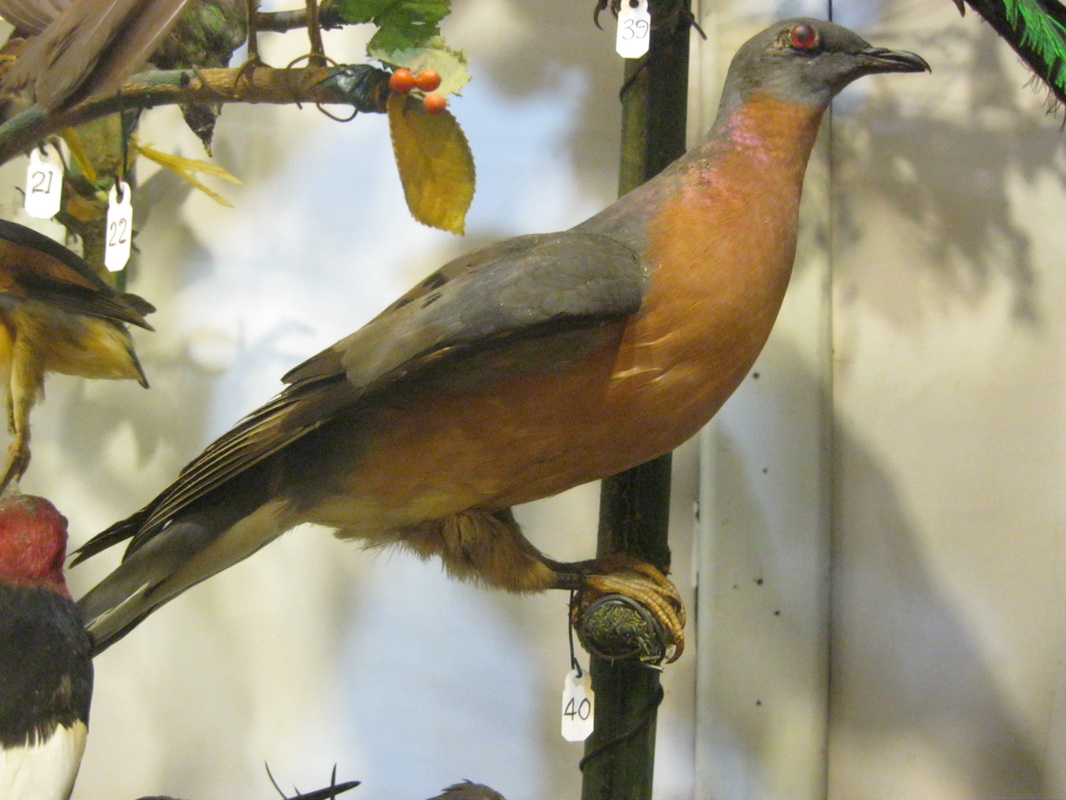BIRDS
Here is an example of one of the birds in the cases at the Patterson Library.

A Passenger Pigeon or Wild Pigeon, just one of two rare specimens that are owned by the Patterson, though one is on loan to SUNY Fredonia.
In the late 1800′s enormous flocks flew over North America, by some reports taking 14 hours to pass over head. Estimates put the flock sizes at over 3.5 billion birds. Due to loss of habitat and over-hunting, Passenger Pigeons went extinct on September 1, 1914 when the last surviving specimen died in the Cincinnati Zoo.
Few preserved specimens exist today in public view and the Patterson has one of the few.
Do you think you can identify birds? Please visit our unidentified birds page and see if you can identify these crazy feathered things.
Please see our different case pages for more birds and to help us identify some.
Please see our different case pages for more birds and to help us identify some.
Visit us and see if you can find and name all the birds at the Patterson....
Birds at the Patterson library
Since 1908 when the Patterson Library opened, visitors have been enjoying these well-preserved bird specimens. The collection includes a rare passenger pigeon (seen above) a species that has been extinct for almost 100 years. In the 1970’s Dr. Willard F. Stanley of SUNY Fredonia identified most of the birds in the collection. An extremely difficult task because the birds come from all over the world. More recently Patterson Library’s Helping Hands Volunteer group cleaned the birds and their display with guidance of the Buffalo Museum of Science.
Currently Volunteer and Library Trustee Sandy Brown is leading a project to photograph each bird and double check the identification with help from internet. Then create a display for each case to give more information about each bird.
Several of the birds remain unidentified, or identified as to family or genus but not to species.
How did the collection come to be?
The Patterson Library received the birds from two sources John D. Patterson and Dr. William J. Moore how the men acquired the birds is a mystery.
John D. Patterson’s collection was donated by the estate of his descendant, Alfred Patterson.
Dr. Moore the grandson of James McClurg, the pioneer who built the McClurg Mansion, left his collection to the Village of Westfield who donated it to the library.
Facts:
Case 10 is dated 1847 which makes some of the birds over 160 years old.
The oldest documentation of collection is an insurance report hand written by John D. Patterson in November 1877 well before library was established in 1896
Since 1908 when the Patterson Library opened, visitors have been enjoying these well-preserved bird specimens. The collection includes a rare passenger pigeon (seen above) a species that has been extinct for almost 100 years. In the 1970’s Dr. Willard F. Stanley of SUNY Fredonia identified most of the birds in the collection. An extremely difficult task because the birds come from all over the world. More recently Patterson Library’s Helping Hands Volunteer group cleaned the birds and their display with guidance of the Buffalo Museum of Science.
Currently Volunteer and Library Trustee Sandy Brown is leading a project to photograph each bird and double check the identification with help from internet. Then create a display for each case to give more information about each bird.
Several of the birds remain unidentified, or identified as to family or genus but not to species.
How did the collection come to be?
The Patterson Library received the birds from two sources John D. Patterson and Dr. William J. Moore how the men acquired the birds is a mystery.
John D. Patterson’s collection was donated by the estate of his descendant, Alfred Patterson.
Dr. Moore the grandson of James McClurg, the pioneer who built the McClurg Mansion, left his collection to the Village of Westfield who donated it to the library.
Facts:
Case 10 is dated 1847 which makes some of the birds over 160 years old.
The oldest documentation of collection is an insurance report hand written by John D. Patterson in November 1877 well before library was established in 1896
